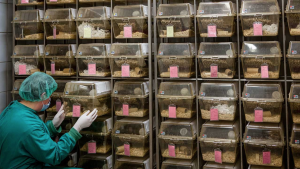



According to a recent study, one-third of cancer patients suffer from anxiety, depression, or adjustment disorder in the months following their diagnosis. As a result, many of them add prescription anxiolytic (anti-anxiety) and antidepressant drugs to their cocktail of chemotherapy, radiation therapy, anti-coagulants, and antibiotic drugs.
The problem is that some of these anxiolytic and antidepressant drugs interact with cancer treatments and are less effective in cancer patients. They also trigger a horde of negative side effects that compound the side effects of regular cancer treatments, including seizures, headaches, and addiction.
A group of scientists at the Memorial Sloan Kettering Cancer Center in New York City decided to take a closer look at alternative herbal remedies to treat anxiety and depression in cancer patients. Research done on herbal supplements and plant extracts has been scarce, so the scientists examined a collection of studies completed between 1996 and 2016. By gathering and organizing the data, they noticed that not only are several alternative remedies helpful in ameliorating anxiety and depression, they also counteract aversive effects of chemotherapy and even combat cancer themselves. While not a perfect substitute, the following herbs have promising potential:
1. Extracts of saffron, a spice derived from a Middle Eastern flower, may be able to treat mild to moderate anxiety about as well as fluoxetine (Prozac) and imipramine (Tofranil). It has also been successful in easing anxiety and depression caused by PMS in women.
2. Lavender pills, made from oil of the lavender plant, are able to treat anxiety comparable to the drugs paroxetine (Paxil) and lorazepam (Ativan), but with fewer side effects. Lavender lotions and diffuser oils are often advertised for their calming and relaxation properties, and this holds true for lavender tea and extract drops, which may increase the efficacy of antidepressants citalopram (Celexa) and imipramine (Tofranil).
3. Passionflower, although no better than prescription drugs, seems to perform similarly but with fewer side effects, when compared to oxazepam (Serax) and sertraline (Zoloft). This substance also comes from a flower, which Native Americans have historically used to prevent insomnia.
4. Chasteberry, typically used for PMS symptoms, was compared to fluoxetine (Prozac), and while it didn’t seem to address psychological symptoms of depression, including persistent sadness, hopelessness, and loss of interest, it did alleviate physical symptoms, such as sleep trouble, digestive problems, muscle aches, and headaches.
Overall, researchers found that the herbs are not as potent, but are safer than the prescription counterparts. Clinical trials are needed to further analyze the potential of these herbal supplements and determine their benefits, especially within a oncology context. Because these supplements can be purchased over the counter, physicians don’t always know which supplements their patients are taking. It’s important to discuss an alternative treatment plan with a doctor before use.
Source:
Simon Yeung, K., Hernandez, M., Mao, J.J, Haviland, I., & Gubili, J. (2018). Herbal medicine for depression and anxiety: A systematic review with assessment of potential psycho-oncologic relevance. Phythother Res. [Epub ahead of print]. doi: 10.1002/ptr.6033

